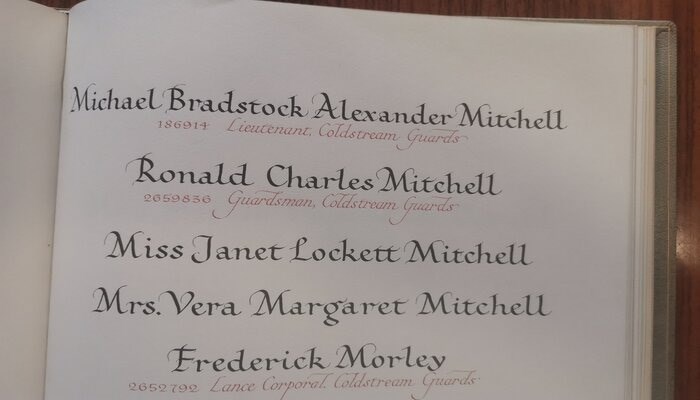
The V1 Attack on the Guards' Chapel

Our founder, Stephen Mitchell (1789-1874) never married and had no children. However, as he was the first of ten siblings, there is much detail relating to his extended family. Research has led to new discoveries, including a moving story in tragic circumstances, involving the immediate family of Alexander Black Mitchell (1880-1972), Stephen Mitchell’s fraternal great-nephew (the grandson of his brother, Nelson).
Exactly one week after D-Day (6 June 1944), the start of the Allied invasion of Normandy, the Germans launched their V-1 offensive campaign across the English Channel. Nazi propaganda minister, Joseph Goebbels, announced that Vergeltungswaffen-1 (Vengeance Weapon-1), had been used in retaliation for the allied invasion of Normandy. Developed by the Luftwaffe, this jet-propelled terror missile was otherwise known as the ‘flying bomb’, ‘buzz bomb’, or ‘doodlebug’.
Over 80 days and nights, around 3000 of these pilotless, one-ton explosive warheads were launched from ramps, travelling at a speed of over 400 miles per hour: while some were intercepted, others got through, the first to hit London landing in the East End, killing six people.
Targeting schools, hospitals and landmarks, the V-1 brought death, pain and chaos: their blind, impersonal nature made people feel helpless. Personal accounts describe their distinctive sound, a roaring, droning and sputtering until, suddenly, there was silence, which indicated that, in a matter of seconds, the bomb was about to drop on its target.
The most serious V-1 attack on London of World War II hit the Royal Military Chapel (also known as the Guards’ Chapel as it serves the seven Army Regiments of His Majesty the King’s Household Division) in Wellington Barracks, St. James’ Park near Buckingham Palace. That Sunday, 18 June 1944, in the midst of a Thanksgiving Service for the success of the Normandy landings, a roaring overhead drowned out the singing of the congregation, which included many guardsmen and their families.
The explosion killed 121 military personnel and civilians, and seriously injured 141 more, including five musicians from the Band of the Coldstream Guards and their Director of Music, Major Causley Windram. Only the Bishop of Maidstone was unhurt, having been sheltered from the blast by the portico from which he was conducting the service. The rescue effort lasted for two days. The chapel itself was completely destroyed, with the exception of the apse, the silver altar cross and six silver candlesticks, whose candles continued to burn, and have remained lit ever since.
The dead and wounded of the attack are commemorated in Jan Gore’s book, Send More Shrouds: The V1 Attack on the Guards' Chapel 1944 (2017), which provides brief biographies of the victims. This source reveals that Alexander Black Mitchell’s wife, eldest son, and only daughter, had all been killed in the Guards’ Chapel bombing of 18 June 1944: Vera, a 50 year-old Women’s Voluntary Service volunteer, Michael, a 22 year-old Lieutenant in the 3rd battalion of the Coldstream Guards, and Janet, a 20 year-old Red Cross nurse.
Alexander Black Mitchell was a Director of the Imperial Tobacco Company, based in Bristol, and a Major in the Somerset Light Infantry. He and his family lived at Poulton Priory, Fairford, near Cirencester, Gloucestershire. In the eastern wing of the nearby Church of St Michael and All Angels, Mitchell dedicated a memorial and stained glass window to his family, with the following inscription:
IN MEMORY OF VERA MARGARET MITCHELL AND | OF HER SON, MICHAEL BRADSTOCK ALEXANDER | MITCHELL, LT COLDSTREAM GUARDS AND | OF HER DAUGHTER, JANET LOCKETT MITCHELL | RED CROSS NURSE, WHO ALL LOST THEIR LIVES | THROUGH ENEMY ACTION ON JUNE 18TH 1944
On VE (Victory in Europe) Day, 8 May 1945, a drumhead Thanksgiving Service was held in front of the ruins of the Guards’ Chapel. In 1955-6, a War Memorial Cloister was dedicated there to those members of the Household Division who died in World War II. A new building was created in 1963, incorporating the original apse and cross, and a 70th anniversary commemoration service was held there in 2014. Today, it is the only remaining military chapel in London. The ‘doodlebug summer’ of 1944 caused enormous damage, destroying 23,000 and damaging around one million buildings; more than 5,000 lives were lost, not to mention the countless numbers physically wounded and mentally broken.
Book of Remembrance Sunday 18th June 1944

